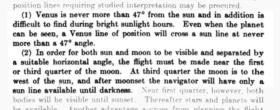
NavList:
A Community Devoted to the Preservation and Practice of Celestial Navigation and Other Methods of Traditional Wayfinding
From: Frank Reed
Date: 2017 Sep 25, 15:43 -0700
David Pike, you may have missed my post from a few days ago, which was, coincidentally, asking almost exactly the same question based on an error in an aerial navigation book from 75 years ago.
I wrote previously:
I was looking at a book on aerial navigation from the 1940s a few days ago and came across a little bit of confusion (see the attached image). What mistake is this author making? Or, to put it differently, in what parts of the world would this advice be reasonably correct, and in what parts of the world could it be quite wrong?
Do you see it's the same issue? If Venus and the Moon are separated by 47° on the celestial sphere, this certainly does not imply that the azimuth difference would always be less than 47°, as the author states. He has confused azimuth difference with angular separation. Of course, we can always calculate azimuth difference, but there's no simple "rule of thumb" (as you have already noted). On any given date at the exact same instant of GMT, with Venus and the Sun separated by 47° in the sky, the azimuth separation could be 47° --in certain parts of the world-- or it could be 180° or 0° or anything in between! You just have to do the spherical trig, or let an app do the same. :)
Frank Reed







